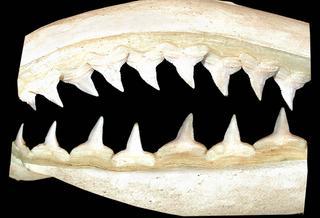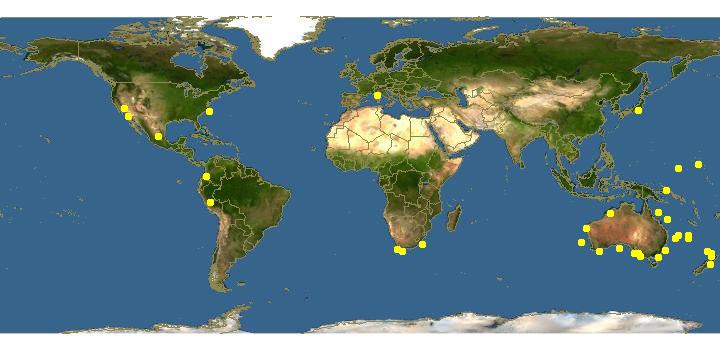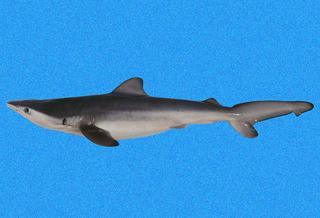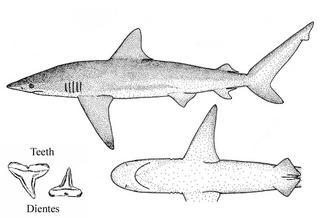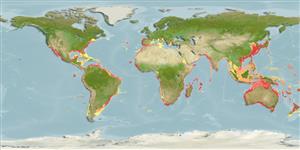|
| Links |
We parsed the following live from the Web into this page. Such content is managed by its original site and not cached on Discover Life. Please send feedback and corrections directly to the source. See original regarding copyrights and terms of use.
- Australian Faunal Directory
- FishBase
|
|
español |
|
|
Overview |
Main identification features
- slender; snout rounded
- 1st dorsal fin : high, origin over rear edge pectoral
- top teeth narrow, hooked
- pectoral: long, straight
Body slender; snout rounded, its length = to or < width of mouth but > distance between nostrils; nasal orifices small and well separated; round eye; spiracle absent; upper front teeth narrow and hooked, with finely serrated points; 5 short gill slits, last 2 over pectoral fin base; first dorsal high, front edge straight, origin over or just behind rear edge of pectoral; second dorsal moderately high, origin over anal origin; pectoral long, straight; no raised crest on back between dorsal fins; tail strongly asymmetrical, with well developed lower lobe, undulating ridge along dorsal surface of top lobe, and a ventral notch near tip of that lobe; notch on top of tail base; distinct bulge on top of base of tail fin.
Dark grey-brown above, belly whitish; tips of pelvics and tips and rear borders of pectorals dark to blackish.
Size: 325 cm.
Habitat: inshore to offshore, continental, from surfline deeper.
Depth: 0-360 m.
Circumglobal; California to the Gulf of California and central Mexico, the Revillagigedos, Peru.
Attributes
Abundance: Common.
Cites: Not listed.
Climate Zone: North Temperate (Californian Province &/or Northern Gulf of California); Northern Subtropical (Cortez Province + Sinaloan Gap); Northern Tropical (Mexican Province to Nicaragua + Revillagigedos).
Depth Range Max: 360 m.
Depth Range Min: 0 m.
Diet: octopus/squid/cuttlefish; bony fishes.
Eastern Pacific Range: Northern limit=33; Southern limit=-9; Western limit=-118; Eastern limit=-79; Latitudinal range=42; Longitudinal range=39.
Egg Type: Live birth; No pelagic larva.
Feeding Group: Carnivore.
FishBase Habitat: Pelagic.
Global Endemism: Circumtropical ( Indian + Pacific + Atlantic Oceans); East Pacific + Atlantic (East +/or West); East Pacific + East (not West) Atlantic; TEP non-endemic; West + East Pacific (but not Central); "Transpacific" (East + Central &/or West Pacific); All species.
Habitat: Water column.
Inshore Offshore: Inshore; Offshore; In & Offshore.
IUCN Red List: Near threatened; Listed.
Length Max: 325 cm.
Regional Endemism: Island (s); Continent; Continent + Island (s); Tropical Eastern Pacific (TEP) non-endemic; Eastern Pacific non-endemic; California + Peruvian provinces, primarily; Temperate Eastern Pacific, primarily; All species.
Residency: Resident.
Salinity: Marine; Marine Only.
Water Column Position: Mid Water; Near Bottom; Near Surface; Surface; Water column only;
|
|
|
Names | |
|
|
|
Links to other sites | |
|
|
|
References |
- Bellido-Millán, J.M. and Villavicencio-Garayzar, C.J., 2002., Pesqueria artesanal de tiburon en la region central del Golfo de California. En: Lozano-Vilano, M. L. (Ed.). Libro Jubilar en Honor al Dr. Salvador Contreras Balderas., Universidad Autonoma de Nuevo León:143-152.
- Béarez, P., 1996., Lista de los Peces Marinos del Ecuador Continental., Revista de Biologia Tropical, 44:731-741.
- Castro-Aguirre, J.L. and Balart, E.F., 2002., La ictiofauna de las islas Revillagigedos y sus relaciones zoogeograficas, con comentarios acerca de su origen y evolucion. En: Lozano-Vilano, M. L. (Ed.). Libro Jubilar en Honor al Dr. Salvador Contreras Balderas., Universidad Autonoma de Nuevo León:153-170.
- Compagno, L.J.V., 1999., Checklist of living elasmobranchs. In Hamlett W.C. (ed.) Sharks, skates, and rays: the biology of elasmobranch fishes., The John Hopkins University Press:471-498.
- Compagno, L.J.V., 1984., Sharks of the World. An annotated and illustrated catalogue of shark species known to date. Part 2. Carcharhiniformes. FAO Species Catalogue., FAO Fish. Synop. No 125, 4(2):251-655.
- Eschmeyer , W. N. , Herald , E. S. and Hamman, H., 1983., A field guide to Pacific coast fishes of North America from the Gulf of Alaska to Baja California. Peterson Field Guide Ser. 28., Houghton Mifflin:336pp.
- Findley, L.T., Hendrickx, M.E., Brusca, R.C., van der Heiden, A.M., Hastings, P.A., Torre, J., 2003., Diversidad de la Macrofauna Marina del Golfo de California, Mexico., CD-ROM versión 1.0. Projecto de la Macrofauna del Golfo . Derechos reservados de los autores y Conservación Internacional.
- Fischer , W. , Krup , F. , Schneider , W. , Sommer , C. , Carpenter , K. E. and Niem, V. H., 1995., Guia FAO para la Identificacion de Especies de para los fines de la Pesca. Pacifico Centro-Oriental. Volumen II. Vertebrados - Parte 1., FAO2:647-1200.
- Günther, A., 1870., Catalogue of the fishes in the British Museum. Catalogue of the Physostomi, containing the families Gymnotidae, Symbranchidae, Muraenidae, Pegasidae, and of the Lophobranchii, Plectognathi, Dipnoi, ...[thru] ... Leptocardii, in the British Museum., Brithish Museum (Natural History)8:1-549.
- Jimenez-Prado, P., Béarez, P., 2004., Peces marinos del Ecuador continental / Marine fishes of continental Ecuador., SIMBIOE/NAZCA/IFEA tomo 1 y 2.
- Jordan , D.S. and Bollman, C.H., 1890., Descriptions of new species of fishes collected at the Galapagos Islands and along the coast of the United States of Colombia, 1887-88, by the U.S. Fish Commission steamer 'Albatross'., Proc. U.S. Nat. Mus., 12:149-183.
- Jordan, D.S., 1895., The fishes of Sinaloa., Proceedings of the California Academy of Sciences (Series 2), 5:377-514.
- Love, M.S., Mecklenburg, C.W., Mecklenburg, T.A., Thorsteinson, L.K., 2005., es of the West Coast and Alaska: a checklist of North Pacific and Artic Ocena species from Baja California to the Alaska-Yukon border., U.S. Department of the Interior, U.S. Geological Survey, Biological Resources Division, 288pp.
- Madrid Vera , J. , Ruíz Luna , A. and Rosado Bravo, I., 1998., Peces de la plataforma continental de Michoacán y sus relaciones regionales en el Pacífico mexicano., Revista de Biologia Tropical, 42(2):267-276.
- Meek , S.E. and Hildebrand, S.F., 1923., The marine fishes of Panama. Part I., Field Mus. Nat. Hist., Zool. Ser. Publ., XV:1-330.
- Van der Heiden , A. M. and Findley, L. T., 1988., Lista de los peces marinos del sur de Sinaloa, México., Anales del Centro de Ciencias del Mar y Limnologia de la Universidad Autonoma Nacional de Mexico, 15:209-224.
- Walker, B. W. and Baldwin, W. J., 1964., Provisional check list of fishes of the Revillagigedo islands., 18 pp.
|
|
|
Acknowledgements | |
I thank Ashley MacDonald and John Pickering, University of Georgia, for technical support in building this page.
|
|
| Supported by | |
|
Following modified from Australian Faunal Directory
|
Top | See original
| &pull 20q v5.145 20180528: Error 301 Moved Permanently http://biodiversity.org.au/afd/taxa/d304ef9f-6d07-4e49-82be-65e466b17c23 |
|
Following modified from FishBase
|
Top | See original
http://www.fishbase.org/Summary/speciesSummary.php?genusname=Carcharhinus&speciesname=brachyurus ---> http://52.67.158.155/Summary/speciesSummary.php?genusname=Carcharhinus&speciesname=brachyurus
http://52.67.158.155/Summary/speciesSummary.php?genusname=Carcharhinus&speciesname=brachyurus ---> https://fishbase.net.br/Summary/speciesSummary.php?genusname=Carcharhinus&speciesname=brachyurus
https://fishbase.net.br/Summary/speciesSummary.php?genusname=Carcharhinus&speciesname=brachyurus ---> https://fishbase.net.br/summary/Carcharhinus-brachyurus.html
Carcharhinus brachyurus, Copper shark : fisheries, gamefish

You can
sponsor
this page
Common name (e.g. trout)
Genus + Species (e.g. Gadus morhua)
-

-
About this page
-
Languages
-
User feedbacks
-
Citation
-
Uploads
-
Related species
-


 Copper shark
Add your observation in
Fish Watcher
Upload your
photos
and
videos
Copper shark
Add your observation in
Fish Watcher
Upload your
photos
and
videos
Pictures
|
Videos |
Google image
 Carcharhinus brachyurus
Carcharhinus brachyurus
Picture by
Smith, B.
Elasmobranchii (sharks and rays) >
Carcharhiniformes
(Ground sharks) >
Carcharhinidae
(Requiem sharks)
Etymology:
Carcharhinus:
karcharos
(Gr.), sharp or jagged;
rhinus
, an ancient name for sharks, from
rhine
(Gr.), rasp, both words alluding to a shark's jagged, rasp-like skin. (
See ETYFish
)
;
brachyurus:
a-
(Gr.), not;
carenatus
, alternate spelling of
carinatus
(L.), keeled or carinate, referring to absence of dermal fold (dorsal ridge) between the dorsal fins [treated as a junior synonym of
C. brachyurus
by some workers]. (
See ETYFish
)
.
More on author:
Günther
.
Environment: milieu / climate zone / depth range / distribution range
Ecology
Marine; brackish; reef-associated; oceanodromous (Ref.
51243
); depth range 0 - 360 m (Ref.
58018
). Subtropical; 45°N - 52°S, 122°W - 180°E
Western Atlantic: Mexico, Gulf of Mexico, Brazil to Argentina. Eastern Atlantic: off France southward and around the coast of southern Africa to central Natal, South Africa (Ref.
5578
), including the Mediterranean. Possibly two separate populations in southern Africa (Ref.
3209
). Western Pacific: Japan to New Zealand. Eastern Pacific: southern California, USA to the Gulf of California in Mexico and Peru.
Length at first maturity / Size / Weight / Age
Maturity: L
m
230.0
, range 245 - 240 cm
Max length : 325 cm TL male/unsexed; (Ref.
2334
); max. published weight: 304.6 kg (Ref.
40637
); max. reported age: 30 years (Ref.
3209
)
Dorsal
spines
(total): 0;
Dorsal
soft rays
(total): 0;
Anal
spines
: 0;
Anal
soft rays
: 0. A large shark to with a bluntly pointed, broad snout, narrow, bent cusps on the upper teeth, and with no interdorsal ridge (Ref.
5578
). Grey to bronzy in color, white below (Ref.
5578
); fins mostly plain except for dusky tips on pelvic fins, as well as dusky to black tips and rear edges on pectoral fins (Ref.
9997
).
A coastal and offshore shark (Ref.
9997
) found along continental margins in most tropical and temperate seas. Occasionally enters large coastal bays and inshore areas (Ref.
6390
). Occasionally found near the bottom (Ref.
6808
). Migratory in the northern part of its range, moving northward in spring and summer and southward in autumn and winter (Ref.
244
). Feeds on pelagic and bottom bony fishes, cephalopods, and small sharks and rays (Ref.
5578
). Viviparous (Ref.
50449
). Undoubtedly utilized for human consumption where it occurs (Ref.
244
). Implicated in shark attacks on people (Ref.
9997
).
Viviparous, with a yolk-sac placenta. Litter contains 7 to 20 pups (Ref.
6871
,
6390
). Young born at 59 - 70 cm TL (Ref.
6390
). Pupping may occur at any time of the year but there is a peak in births in summer (Ref.
6390
). Distinct pairing with embrace (Ref.
205
).
Compagno, L.J.V.
, 1984. FAO Species Catalogue. Vol. 4. Sharks of the world. An annotated and illustrated catalogue of shark species known to date. Part 2 - Carcharhiniformes. FAO Fish. Synop. 125(4/2):251-655. Rome: FAO. (Ref.
244
)
IUCN Red List Status (Ref.
130435
)
Vulnerable (VU)
(A2bd); Date assessed:
06 April 2020
CITES
Appendix II:
International trade monitored
Not Evaluated
Threat to humans
Traumatogenic (Ref.
4690
)
Human uses
Fisheries: minor commercial; gamefish: yes
FAO - Fisheries:
landings
; Publication:
search
|
FishSource
|
Sea Around Us
More information
Countries
FAO areas
Ecosystems
Occurrences
Introductions
Stocks
Ecology
Diet
Food items
Food consumption
Ration
Common names
Synonyms
Metabolism
Predators
Ecotoxicology
Reproduction
Maturity
Spawning
Spawning aggregation
Fecundity
Eggs
Egg development
Age/Size
Growth
Length-weight
Length-length
Length-frequencies
Morphometrics
Morphology
Larvae
Larval dynamics
Recruitment
Abundance
BRUVS
References
Aquaculture
Aquaculture profile
Strains
Genetics
Electrophoreses
Heritability
Diseases
Processing
Nutrients
Mass conversion
Collaborators
Pictures
Stamps, Coins Misc.
Sounds
Ciguatera
Speed
Swim. type
Gill area
Otoliths
Brains
Vision
Tools
E-book
|
Field guide
|
Identification keys
|
Length-frequency wizard
|
Life-history tool
|
Point map
|
Classification Tree
|
Catch-MSY
|
Special reports
Check for Aquarium maintenance
|
Check for Species Fact Sheets
|
Check for Aquaculture Fact Sheets
Download XML
Summary page
|
Point data
|
Common names
|
Photos
Internet sources
AFORO (otoliths) |
Aquatic Commons
|
BHL
|
Cloffa
|
BOLDSystems
|
Websites from users
|
Check FishWatcher
|
CISTI
|
Catalog of Fishes
:
genus
,
species
|
DiscoverLife
|
ECOTOX
| FAO - Fisheries:
landings
; Publication:
search
|
Faunafri
| Fishipedia |
Fishtrace
| GenBank:
genome
,
nucleotide
|
GloBI
|
Google Books
|
Google Scholar
|
Google
|
IGFA World Record
|
MitoFish
|
National databases
|
Otolith Atlas of Taiwan Fishes
|
PubMed
|
Reef Life Survey
| Socotra Atlas |
Tree of Life
| Wikipedia:
Go
,
Search
| World Records Freshwater Fishing |
Zoological Record
Estimates based on models
Preferred temperature (Ref.
123201
): 11.6 - 23.8, mean 17.4 °C (based on 797 cells).
Phylogenetic diversity index (Ref.
82804
): PD
50
= 0.5000 [Uniqueness, from 0.5 = low to 2.0 = high].
Bayesian length-weight: a=0.00468 (0.00230 - 0.00950), b=3.08 (2.91 - 3.25), in cm total length, based on LWR estimates for this species & Genus-body shape (Ref.
93245
).
Trophic level (Ref.
69278
): 4.5 ±0.0 se; based on diet studies.
Generation time: 28.9 ( na - na) years. Estimated as median ln(3)/K based on 1
growth studies.
Resilience (Ref.
120179
): Very Low, minimum population doubling time more than 14 years (K=0.04; tm=5-20; tmax=30; Fec=7).
Fishing Vulnerability (Ref.
59153
): Very high vulnerability (87 of 100).
Climate Vulnerability (Ref.
125649
): High vulnerability (57 of 100).
Price category (Ref.
80766
):
High
.
Nutrients (Ref.
124155
): Calcium = 2.54 [0.47, 14.40] mg/100g; Iron = 0.3 [0.1, 0.9] mg/100g; Protein = 23 [20, 25] %; Omega3 = 0.172 [0.060, 0.438] g/100g; Selenium = 19.4 [5.6, 61.2] μg/100g; VitaminA = 30.3 [7.9, 119.7] μg/100g; Zinc = 0.413 [0.195, 0.829] mg/100g (wet weight);
Back to Search
Random Species
Back to Top
Accessed through:
Not available
FishBase mirror site :
Laguna, Philippines
Page last modified by :
mrius-barile
|
Updated: 2024-04-26 13:00:51 gmt
|
